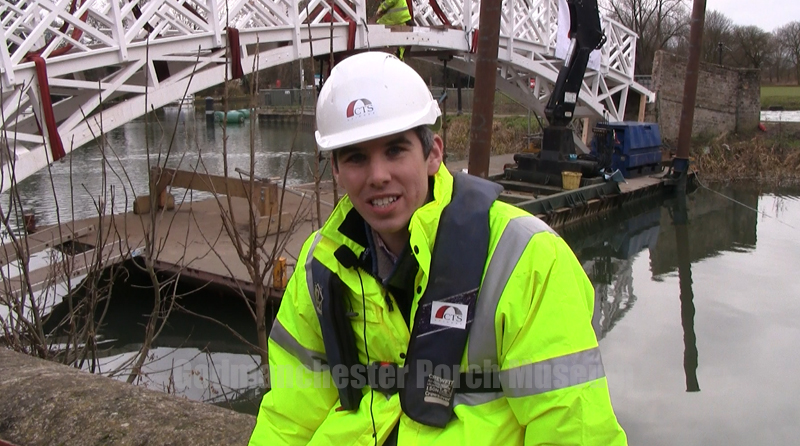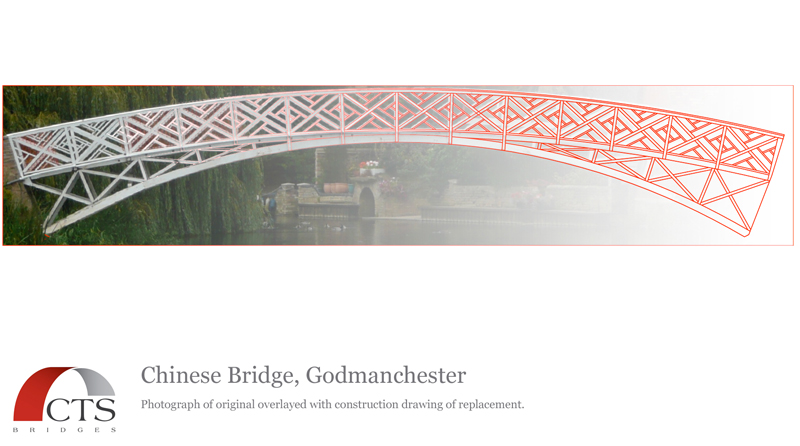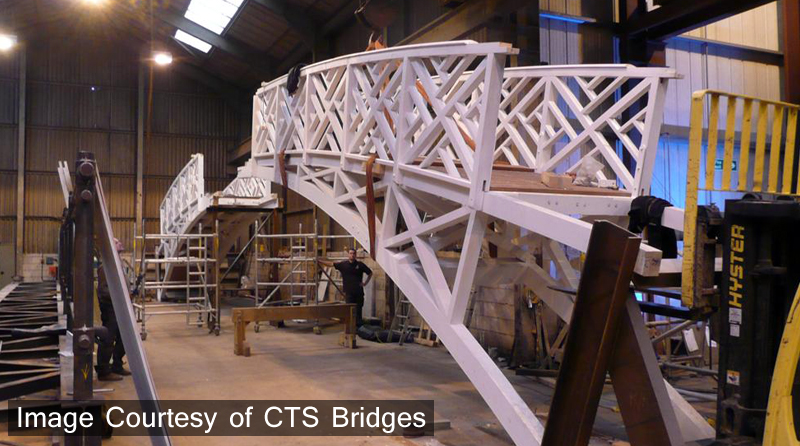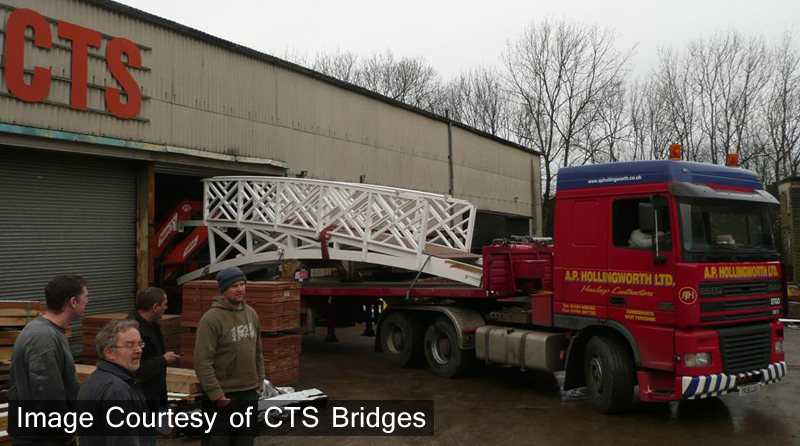I'm Simon Newby I'm the structural Engineer fore CTS Bridges and we carried out the design on the bridge and fabricated it in our factory in West Yorkshire. What you see behind us now is the culmination of the last two days of installation work but prior to that we've been working on the bridge since last summer when I came down here and took dimensions of all the abutments.
fabricated it in our factory in West Yorkshire. What you see behind us now is the culmination of the last two days of installation work but prior to that we've been working on the bridge since last summer when I came down here and took dimensions of all the abutments.
I'm looking relatively relaxed now because we've successfully installed it in between the two abutments which are a fixed distance apart. It was quiet a tricky one to measure because there are 4 points of contact on each abutment and there's a lot of things to get true and lined up. But as you can see its worked very well and we thought we were going to have to do a bit of jiggery pokery and install the second half once, take it out, remeasure, cut some off, put it back, but in fact we've actually just put it in first time and it slotted into place.
And what you see behind me now is just the final adjustments to make sure we've got direct bearing at the centre of the arch. And latter this afternoon we're going to be shimming, or we've already shimmed the base plates and we just going to be grouting up the pockets were the arch disappears into the wall and that will set it firm into the abutments.
Tomorrow we're going to come back and start the rest of the work on the bridge, there's still about another 3 or 4 days work to do we think. Were going to install the missing parts of the parapet the centre of the bridge and at the abutments and fit the top rail for twehe hand rail and there's also some diagonal raking members which need to come out of the abutments which should hopefully reduce how much it wobbles and make it into a stable structure.
So this bridge is a faithful reproduction of the bridge that was already there, but in design terms we had to start from scratch as though it was a new bridge and justify it to modern loading standard's and modern codes of practice. So underneath what you see there are a few subtle tweaks to the fixings and the way we have connected it together which should make it stronger and more robust in service. But effectively it was designed from scratch as a new structure. The biggest thing we increased the strength of was the hand rail which was woefully undersized for the task but now should be a lot more robust. The bridge itself is a complete replica of what was already there, so we had to use all the same materials.
from scratch as though it was a new bridge and justify it to modern loading standard's and modern codes of practice. So underneath what you see there are a few subtle tweaks to the fixings and the way we have connected it together which should make it stronger and more robust in service. But effectively it was designed from scratch as a new structure. The biggest thing we increased the strength of was the hand rail which was woefully undersized for the task but now should be a lot more robust. The bridge itself is a complete replica of what was already there, so we had to use all the same materials.
The structure is actually a mixture of woods. The lower arches which are doing most of the work are made out of tropical hardwood called Green heart which is very very strong and very durable used a lot in the marine industry. All of the rest of the structure below deck level is Oak. The bridge is made of exactly the same materials as the bridge we've just taken down last week. So its a mixture of woods, the lower arches which are doing most of the work are made out of a tropical hardwood called Green heart, which is just about as strong and durable as you can get in timber.
As I say they're are the most highly stressed members in the bridge carrying pretty much all the load of the structure and above that what you see is cross bracing which isn't really doing a great deal other than supporting the deck at a higher level to meet the abutments and all those cross bracing are Oak. Above that the parapet is a mixture of hard woods and the infill parts are soft woods. We've changed the deck slightly, we were allowed to change the deck, so the deck planks are uprated and have more grip on them for pedestrians. In terms of weight both halves of the bridge weighed about three tonnes and we've installed it in a two stage process.
structure and above that what you see is cross bracing which isn't really doing a great deal other than supporting the deck at a higher level to meet the abutments and all those cross bracing are Oak. Above that the parapet is a mixture of hard woods and the infill parts are soft woods. We've changed the deck slightly, we were allowed to change the deck, so the deck planks are uprated and have more grip on them for pedestrians. In terms of weight both halves of the bridge weighed about three tonnes and we've installed it in a two stage process.
Yesterdays tasks were to get the first half in line it up and measure it. We then took it down and the second day today we've put the next half in and as you can see it fits. Because of the way the new bridge has to fit i.e. it needs to fit very tight against the existing abutments, it wasn't possible to install the bridge as a single piece so we had to bring it in in two parts. And to do that we've used effectively two small cranes one on the floating barge and another one lorry mounted on the back of a vehicle by the side of me and that's given us quiet a lot of control to make sure two halves of the bridge line up. But as I say it was not possible to install it in one big piece.
For me this was quite an important project because although our company is based in Yorkshire, I actually grew up just up stream in Little Paxton and frequently used to canoe under this bridge during my school days. So for me its got great poignancy in it. Its good to be back in Cambridgeshire doing such a well known local landmark.
I actually grew up just up stream in Little Paxton and frequently used to canoe under this bridge during my school days. So for me its got great poignancy in it. Its good to be back in Cambridgeshire doing such a well known local landmark.